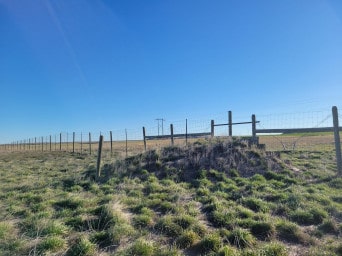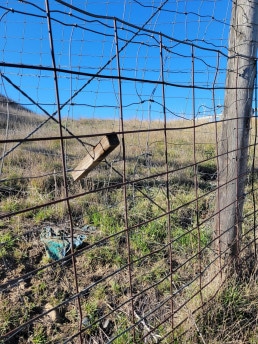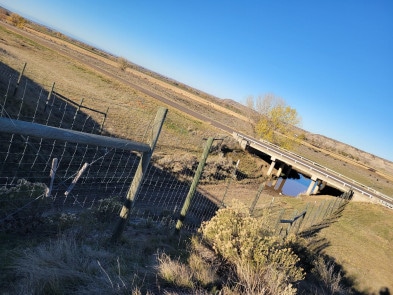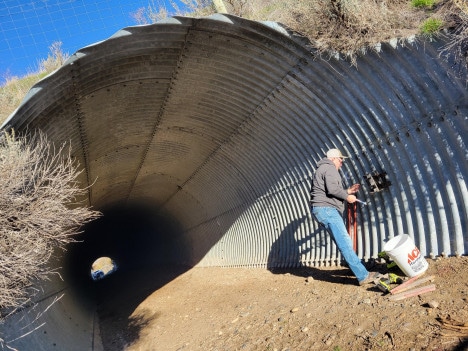While a little delayed, we wanted to share updates from the field from October because the month was filled with fieldwork projects. One of them was getting out in the field to support the Montana Department of Transportation (MDT) with placing trail cameras outside Jordan and removing old game cameras outside Miles City.

MWF was pretty excited to get out and learn more about interactions that occur in Montana to support both wildlife and human safety.
Did you know that fences and roadways can have a large effect on habitat connectivity for a multitude of wildlife species?
Did you know that the MDT employs wildlife biologists and other environmental professionals whose work is substantial, and encompasses monitoring and tracking wildlife in an effort to make our roads safer for the public to travel?
Did you know that there’s something that you can do to support this work and make a difference? Read on, friends!


If you’ve never looked at a game camera up close, they’re very simple, easy to use devices. MDT Biologists’ use these devices to monitor for various wildlife species that move along and across roadways by taking date and time stamped photographs. These photos provide real time, conclusive data that is used to improve the safety of travelers by affecting change in the design of future road and bridge projects across the state of Montana.
Tracking wildlife movements to better understand what’s happening in a given area prior to and after a project’s development allows MDT to better position various “wildlife accommodations” to improve their effectiveness, and to insure the greatest return on their financial investment.
The main things to be aware of when setting up a trail camera is its location and angle so that it is placed in a good way to capture any wildlife movements (they take photos with any and all movement, so cows are captured too!), and that the game camera is secured to something sturdy so that no amount of any weather-related element will bother it.


Some folks may already know this, but if this sounds new to you, you’re not alone. There’s a lot of work occurring behind the scenes at MDT, from tracking and monitoring wildlife movements and connectivity, to tracking and monitoring human safety issues such as animal-vehicle collisions (AVC), and monitoring the various wildlife accommodations that have already been implemented by MDT.
Wildlife accommodations can be as simple and inexpensive as replacing right-of-way fences that are obstructing wildlife movements, to designing and constructing larger, more expensive wildlife overpasses and underpasses when appropriate. An example of the latter can be witnessed by everyone on U.S. 93 north of Missoula, and along MT Highway 200 in McCone County. MDT recently researched various wildlife-friendly fence designs for their effectiveness in providing for driver safety and, for the protection of the private property, i.e., livestock, of the adjoining landowners.

Highway and bridge projects in Montana can be in development and design from 3 to 6 years, over which time various design strategies are considered and vetted using various data points, and personal interviews with local folks before a project’s actual construction begins. The purpose of all this front-end effort is so that yours and mine and every other person’s tax dollars are allocated in a smart, efficient and safe way when it comes to highway improvements and road changes, with emphasis given to driver safety and the protection of private property, i.e., livestock. Makes sense, right?


A very important aspect of this work is the complete and full understanding of the reasoning that goes into the design and siting of wildlife accommodations by the adjoining landowners. Pictured above is a place in the fence where a landowner had to repeatedly fix the fence due to wildlife trying to get through. Photo taken by MWF staff, Morgan Marks]
To do all of this, MDT biologists pay particular attention to the daily, seasonal, and semi-annual migration patterns of various wildlife species, and records of animal vehicle collisions kept by MDT and state and local law enforcement entities. The acceptance of a wildlife accommodation by adjoining landowner’s and/or State and Federal land management agencies is a paramount consideration to a properly cited and successful wildlife accommodation.
If you’re interested in supporting these efforts and serving as a citizen scientist, there’s a really awesome app that was created by countless conservation partners to track wildlife and work on connecting places through citizen science, called Wildlife Xing. Check out the website and download the app – it’s free, easy to use, and can make a difference in keeping both people and wildlife safe. The Miistakis Institute in Alberta, Canada and the National Wildlife Federation have partnered to prioritize this work. To learn more, check out this video.
Also, if you are a high school teacher or know a teacher who is looking for a migration and connectivity curriculum focused on wildlife, please contact the National Wildlife Federation and Naomi Alhadeff to access their new Wildlife Xing curriculum and be a part of a very exciting pilot project! They’re also looking for community groups and individuals interested in learning about migration and connectivity work, so if you’re interested in learning more and getting involved, please get in touch!
A decade or more ago, MDT completed work along I-94 outside of Miles City to make a segment of this roadway safer, by funneling wildlife to specific locations with wildlife exclusion fencing, where they are able to pass safely beneath the roadway. This MDT Project has dramatically improved the safety of this roadway for travelers and wildlife alike.

Large bridge openings are often the best and most efficient way for wildlife to pass safely from one side of the roadway to the other, followed by large culvert openings when their overall length is kept as short as possible so that wildlife can see through the culvert, otherwise, they may not want to use it and may deem it unsafe.
A few aspects to keep in mind are that wildlife need to move from place to place to find food and habitat, so they’re going to move and find a way, and with that, they want to feel safe when they move. Wildlife prefer to move through spaces that are open, light-filled, and where they feel safe. A dark culvert or long culvert may not allow for light to effectively fill culverts, so they may not always be the best option for MDT to use to help wildlife cross a roadway safely, and they may not be willing to use it initially. Wildlife that can see a skyline likely feel safer and are more willing to attempt a quick passage through a confined space.




Of course, like many things, this work is often complex and not clear cut or straightforward. Gathering data costs money, and so does installing bridges and culverts, so at the end of the day, landowner acceptance and available funding often dictate final decisions. Local advocacy can also aid in these decisions and can help in the public’s understanding about what’s going on and why. The MWF thinks it’s very important to share this work with you and why it’s happening, and also give you action steps if you want to help and learn more.
Thanks very much for reading and taking the time to learn more about migration and connectivity issues! Check out the MWF Facebook page for upcoming events, volunteer opportunities, and to see when we’ll be showing up in a town near you.
Please help the MWF spread the word about the fieldwork we are involved in, and the work that is going on around the state by sharing blogs like this to your social media and forwarding them to your family, friends and any other folks who may be interested in seeing what we’re up to!
For questions, suggestions about fieldwork opportunities, to get involved as a volunteer, and to share upcoming events you think would be great for MWF to show up at, please email or call Morgan at 406-403-4464 or morgan@mtwf.org
See you in the field,
MWF Field Team

